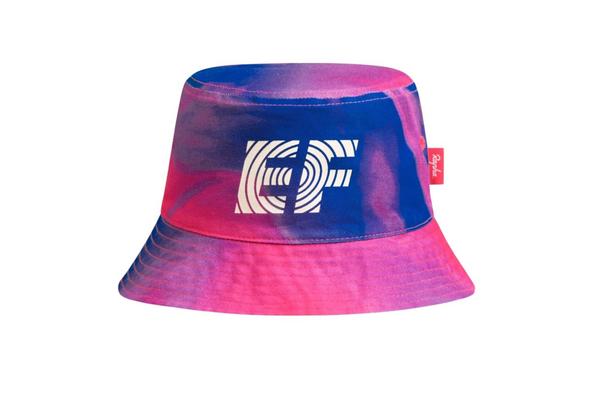
The 500: Rapha Bucket Hat
iiii MagazineEssay
iiii Magazine
Essay
2019
In January this year, Rapha revealed the new kit collection for EF Education First Pro Cycling, a team atop the pile of the cycling world’s pros. For those who wait patiently for the release of a cycling team’s new kit for the upcoming season, there was, for once, a reward. In pink and blue acid-wash psychedelia the kit stands out against the drab, conformist blacks and clumsily placed sponsors’ logos of other pro teams’ kits. There was, of course, the usual attire, the shorts and the jerseys, but one item stood out. A bucket hat. Here was an object, a style so different, so at odds with the militant order of the pro teams, and the monkish dedication and sobriety of professional bike riders – an accessory synonymous not with athleticism but rave and 90s drug culture.
Once, rave culture aspired to brands, now brands aspire to rave culture. The subversion, the freedom, the euphoria has been subsumed into the consumable, the safe, the obvious. Rave has been harnessed by capital and the cult of wellbeing.
WE can imagine the bankers, the wealthy MAMILs, clad in Rapha, the 20-somethings too, watching the debauchery of Trainspotting with a sick fascination. Here is another space, a zone in which to operate outside the banality of everyday life. There is something that can be reached through alternate modes of living: thoughts, ideas, connections grasped through the alterity of drug taking, of dancing. Yet this is uncomfortable, antithetical to the ultimate aim of being a productive, health-conscious person. This is a rupture that is desired but proves too disruptive. Thank god Mark Renton made his way onto a treadmill.
After a good night’s sleep we can party in the early hours at a juice rave. Ministry of Sound is not just a club, but a gym. We cannot return to the 90s, no, but we don’t even have to return to the night to get a sense of what the now idolised decade may have been like. We can go to Gymbox, designed by Ben Kelly, who also designed the Haçienda. A recent ad campaign for Gymbox showed the outline of a pill and joked that you could, “Get your heart rate above 150 …legally”. A model citizen is a healthy citizen! Live in the comfort of the law. Get your kicks with a clear conscience. Lose yourself to the music, gurn your teeth, surrounded by the lights, the hazard lines, the concrete. Get ripped. Go hard. Come back to your desk remembering how you went all the way. Tell your boss, they’ll like your idea of fun.
The consumer-spectator needn’t trudge through the ruins and the relics of culture, they can run, jump and cycle through them, harnessing their bodies and realising their physical capabilities. In Against Exercise Mark Greif described exercise as a numbers game, where individuals seek to “discover and regulate the machine-like processes” in their bodies. This is still true, although exercise is now compounded with alternative future visions, which have been stripped from the social and given to the individual. The utopian possibility of the rave has turned into the utopian possibility for one’s own self.
Once, rave culture aspired to brands, now brands aspire to rave culture. The subversion, the freedom, the euphoria has been subsumed into the consumable, the safe, the obvious. Rave has been harnessed by capital and the cult of wellbeing.
WE can imagine the bankers, the wealthy MAMILs, clad in Rapha, the 20-somethings too, watching the debauchery of Trainspotting with a sick fascination. Here is another space, a zone in which to operate outside the banality of everyday life. There is something that can be reached through alternate modes of living: thoughts, ideas, connections grasped through the alterity of drug taking, of dancing. Yet this is uncomfortable, antithetical to the ultimate aim of being a productive, health-conscious person. This is a rupture that is desired but proves too disruptive. Thank god Mark Renton made his way onto a treadmill.
After a good night’s sleep we can party in the early hours at a juice rave. Ministry of Sound is not just a club, but a gym. We cannot return to the 90s, no, but we don’t even have to return to the night to get a sense of what the now idolised decade may have been like. We can go to Gymbox, designed by Ben Kelly, who also designed the Haçienda. A recent ad campaign for Gymbox showed the outline of a pill and joked that you could, “Get your heart rate above 150 …legally”. A model citizen is a healthy citizen! Live in the comfort of the law. Get your kicks with a clear conscience. Lose yourself to the music, gurn your teeth, surrounded by the lights, the hazard lines, the concrete. Get ripped. Go hard. Come back to your desk remembering how you went all the way. Tell your boss, they’ll like your idea of fun.
The consumer-spectator needn’t trudge through the ruins and the relics of culture, they can run, jump and cycle through them, harnessing their bodies and realising their physical capabilities. In Against Exercise Mark Greif described exercise as a numbers game, where individuals seek to “discover and regulate the machine-like processes” in their bodies. This is still true, although exercise is now compounded with alternative future visions, which have been stripped from the social and given to the individual. The utopian possibility of the rave has turned into the utopian possibility for one’s own self.